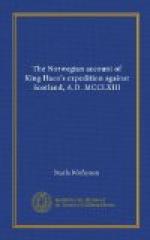[Footnote 81: No doubt the neighbouring inhabitants retired to the isles of Loch-Lomond in times of danger.]
[Footnote 82: i.e. Haco.]
[Footnote 83: i.e. without an awning.]
[Footnote 84: i.e. ships.]
[Footnote 85: i.e., the Scotch.]
[Footnote 86: Kerti-sveina (orig.), i.e. Inspectors of the Lights, who were to see that the Norwegian palace was properly illuminated. The office corresponded exactly to the Canhowllyd of the Welsh Princes.]
[Footnote 87: In the Fl. Ms. the Norwegians are said to have entered the transport.]
[Footnote 88: Fl. MS., Five hundred.]
[Footnote 89: Perus or Pherus (orig.), probably Fergus.]
[Footnote 90: A quotation from Giraldus’s account of the Irish will both illustrate this passage & the antient method of fighting. “Utuntur—securibus quoque amplis, fabrili diligentia optime chalybatis, quas a Norwegiensibus & Oustmannis sunt mutuati. Una tantum manu, & non ambabus, securi percutiunt, pollice desuper manubrium in longum extenso ictu regente, a quo nec galea, caput, in conum erecta, nec reliquum corpus ferrea loricae tricatura tuetur. Unde & in nostris contigit temporibus totam militis coxam ferro utcunque fideliter vestitam, uno securis ictu praecisam fuisse, ex una equi parte coxa cum tibia, ex altera vero, corpore cadente moribundo. Lapides quoque pugillares, cum alia arma defecerint, hostibus in conflictu damnosissimos, prae alia gente promptius, & expeditius ad manum habent.”]
[Footnote 91: Knights at their creation were invested with belts ornamented with gems. See Malmsb., book 2, chap. 6.]
[Footnote 92: A district of Norway.]
[Footnote 93: Melanzeiar (orig.). Fl. Ms. Melas eyiar, perhaps the island of Lamlash or Alisa.]
[Footnote 94: Mylar-Kalf (orig.). Among the Norwegians a small island adjoining to a greater was called its calf, as the calf of Mull, the calf of Man, &c.]
[Footnote 95: A subdivision of Norway.]
[Footnote 96: Yngua (orig.), one of Haco’s predecessors.]
[Footnote 97: Hvarf, (orig.), signifies an intervening ridge that intercepts the prospect—Farohead.]
[Footnote 98: Giafioerd (orig.) Fl. Ms. Goa-fioerd.]
[Footnote 99: October 28.]
[Footnote 100: Asmundar-vogi (orig.), i.e., Asmund’s Bay.]
[Footnote 101: Probably some harbour of the Mainland, one of the Orkneys.]
[Footnote 102: A cape of Pomona.]
[Footnote 103: December 13.]
[Footnote 104: i.e. Herring bay.]
[Footnote 105: i.e. Salmon bay.]
[Footnote 106: March 21.]
[Footnote 107: Here it must be observed that the Norwegian year commenced March 25. So that, according to our reckoning, Haco died in March 1264.]




